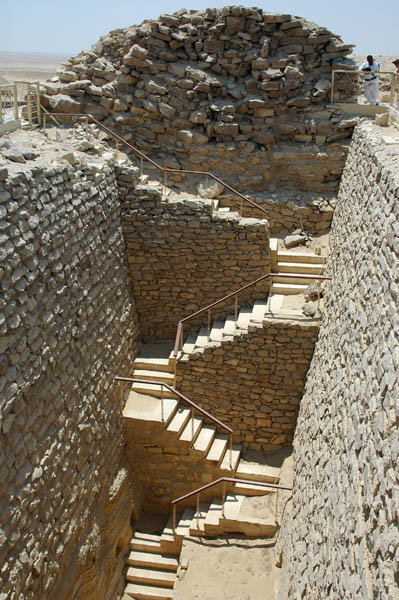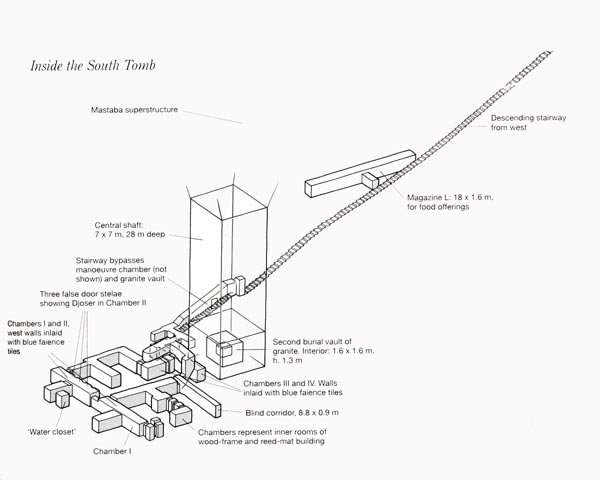- By all Egyptological reckoning the Step Pyramid itself is a functional royal tomb. But in
Djoser's complex, in addition to the Step Pyramid, we find the enigmatic South Tomb. Below it the builders replicated
three essential features of the substructure of the pyramid: the descending corridor; central shaft with the granite
vault; and the king's palace with its blue-tiled chambers. As under the pyramid, the builders blocked the descending
corridor except for a narrow stairway to allow them to bring in whatever it was they placed in the vault. About halfway
down the corridor a side chamber was found filled with large jars. On top of these the workmen had left a wooden
stretcher, box and posts from a baldachin that resemble those of Hetepheres's cache at Giza.
Robbers had done far less damage to the South Tomb than the pyramid itself, so excavators found the manoeuvre chamber
intact. The walls were of large limestone slabs and the underside of the stone ceiling beams had been rounded to imitate
palm logs. As in the pyramid (though here at the south rather than the north end), the burial chamber was entered by a
round aperture. Remarkably, the wooden beam used to lower the granite plug was still in place with traces left by the
ropes still visible. Incorporated into the masonry of the manoeuvre chamber were blocks of fine limestone with
relief-carved stars - remains of a previous vault.
- The granite vault is similar to the one under the pyramid, but it is much smaller, and its
interior was covered in green traces of copper. What was placed in this vault, too small for a human burial? Various
suggestions have been made: that it was a fictive tomb for a ritual death during the Heb-Sed ceremonies when the king
renewed his vital forces; that it was the home of the king's ka; that it was the burial place of the royal placenta,
preserved from birth until death; that it was for the burial of the crowns; or that it was a symbolic reference to the
old tombs at Abydos, be they actual or fictive burial places. Lauer thought it might have been for the king's internal
organs, removed during mummification, though in later times the canopic chest containing these was placed in the same
chamber as the body.
- The entire South Tomb complex may have been intended for the king's ka, and the Egyptians often
gave the ka special funerary treatment by the separate interment of a statue. There is compelling evidence that Khafre's
satellite pyramid was used for a statue burial. The South Tomb may thus be seen as the precursor of later satellite
pyramids. The wooden stretcher, box and poles found in the magazine in the South Tomb may be the ritually disassembled
parts of the apparatus used to carry such a statue.
All indications point to the fact that the South Tomb was finished first: the king's inner palace is far more complete
than that of the pyramid. Chamber I has six panels identical to those under the pyramid, with blue faience tiles laid on
a limestone backing imitating reed-mat facades with a vaulted top supported by djed columns. One contained the real door
from the vestibule. In another chamber three more panels contain false door stelae, while the fourth contains the real
door exiting to a short corridor. Two more chambers are covered, like their counterparts under the pyramid, with blue
faience inlay. The blue-tiled chambers are one of the most impressive features of the Djoser substructure. Ye the
product of this extraordinary care and craftsmanship was never intended to be seen by living eyes; it was meant instead
to ensure something in the king's existence after death. The clue to what that was lies in the false door stelae, which
form the pictorial and textual determinative to the entire underground complex. In the darkest, most in-accessible place
the Egyptian builders could devise, the, used the best of their nascent abilities in relief and text to depict the king
in perpetual communion, not so much with his living subjects, as with the netjeru, the gods and denizens of the
Nether world, where the king's mat palace was now part a the watery, sacred region of primeval reed shrines.
- Source: The Complete Pyramids, Mark Lehner; Thames and Hudson; 1997I

